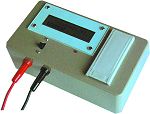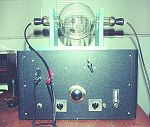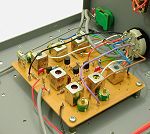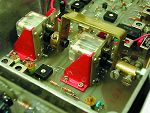
![]() Teach-In
2004 (Part 2) - Our brilliant new introduction to electronics is sub-titled
"How to apply electronics meaningfully". Using the systems approach,
we demonstrate how to apply basic components to form useful sub-systems,
which in turn can be utilised to create useful circuits.
Teach-In
2004 (Part 2) - Our brilliant new introduction to electronics is sub-titled
"How to apply electronics meaningfully". Using the systems approach,
we demonstrate how to apply basic components to form useful sub-systems,
which in turn can be utilised to create useful circuits.
Teach-In 2004 Part 2 includes details of transistors including bipolar and MOSFET types and how they can be used to form amplifiers and electronic switches. We include some basic "breadboard" experiments to enable you to gain some valuable practical experience.
![]() FREE
DOWNLOAD - READ PART ONE OF TEACH-IN 2004 FOR FREE! You can also buy
Back Issues through our Online
Shop, so you won't risk missing any previous installments. Subscribe
now - we accept most major credit cards and we deliver worldwide.
FREE
DOWNLOAD - READ PART ONE OF TEACH-IN 2004 FOR FREE! You can also buy
Back Issues through our Online
Shop, so you won't risk missing any previous installments. Subscribe
now - we accept most major credit cards and we deliver worldwide.
Be sure not to miss this electronics tutorial series, specially written for students, hobbyists and anyone wanting to learn how to use electronic components!

![]() Christmas
Cheeks - a light-emitting novelty that gives your cheeks a festive
glow! This miniature l.e.d. flasher is encapsulated
in polyester and is designed to be worn for short periods inside the mouth.
Its moisture-activated sensor activates the flasher automatically upon
contact with saliva. No other components are exposed to human contact.
Self-contained sealed unit. Note: intended for adult use only. Not
suitable for use by children.
Christmas
Cheeks - a light-emitting novelty that gives your cheeks a festive
glow! This miniature l.e.d. flasher is encapsulated
in polyester and is designed to be worn for short periods inside the mouth.
Its moisture-activated sensor activates the flasher automatically upon
contact with saliva. No other components are exposed to human contact.
Self-contained sealed unit. Note: intended for adult use only. Not
suitable for use by children.

![]() PIC
'NIM' machine - The ancient Chinese
game of 'Nim' is brought right up to date with our PIC microcontroller
powered version. The project simulates the traditional game: a number
of objects (e.g. pebbles or coins) are placed in a number of piles. Each
player takes it in turn to remove one or more objects from one (and only
one) pile, applying simple binary logic. Whoever takes the last object
wins. Our project uses light-emitting diodes as objects and the game proceeds
by using push button switches. Easy stripboard design.
PIC
'NIM' machine - The ancient Chinese
game of 'Nim' is brought right up to date with our PIC microcontroller
powered version. The project simulates the traditional game: a number
of objects (e.g. pebbles or coins) are placed in a number of piles. Each
player takes it in turn to remove one or more objects from one (and only
one) pile, applying simple binary logic. Whoever takes the last object
wins. Our project uses light-emitting diodes as objects and the game proceeds
by using push button switches. Easy stripboard design.
![]()

![]() PIC Virus
Zapper Mk. II - Following on from our first version (March
2002) we present a followup microcontroller version which features
an informative LCD display and other improvements. The basic theory builds
on the claims made by Dr Hulda Regehr Clark and uses an electronic method
of generating a signal which, it is said, may help to combat viruses.
EPE makes no claims whatsoever regarding the efficacy of the unit, so
we present this design purely for the benefit of experimenters to try
out for themselves. However, a number of very positive experiences have
been recorded as a result of using this project. Will it work for you?
Only you can decide.
PIC Virus
Zapper Mk. II - Following on from our first version (March
2002) we present a followup microcontroller version which features
an informative LCD display and other improvements. The basic theory builds
on the claims made by Dr Hulda Regehr Clark and uses an electronic method
of generating a signal which, it is said, may help to combat viruses.
EPE makes no claims whatsoever regarding the efficacy of the unit, so
we present this design purely for the benefit of experimenters to try
out for themselves. However, a number of very positive experiences have
been recorded as a result of using this project. Will it work for you?
Only you can decide.

![]() Must
not be used by anyone with a heart pacemaker, or expectant mothers, or
anyone who may be adversely affected by the use of bio-electric devices.
Must
not be used by anyone with a heart pacemaker, or expectant mothers, or
anyone who may be adversely affected by the use of bio-electric devices.
 PLEASE
TAKE NOTE: (May 2004 issue) Page 849 and 851 transistor TR8 in Fig. 3
should be BC184L and not as shown. Resistor R23 is missing from
the parts list and should be 100 ohms. Under the side-heading "Matching
Transistors" (page 851) TR3 and TR5 should read TR5 and TR6.
PLEASE
TAKE NOTE: (May 2004 issue) Page 849 and 851 transistor TR8 in Fig. 3
should be BC184L and not as shown. Resistor R23 is missing from
the parts list and should be 100 ohms. Under the side-heading "Matching
Transistors" (page 851) TR3 and TR5 should read TR5 and TR6.
Our feature article entitled "Electrotherapy - A Brief History" also in this issue, provides further background information and should be read first. It recounts the development of many electrical techniques that were applied in medicine, from Galvani in the 19th Century through to Regehr Clark.

![]() Practical
Radio Circuits (7) - The Superhet. Our in-depth series demystifies
the Superheterodyne receiver, the most dominant of radio reception techniques.
This top quality series offers plenty of practical opportunities for constructors
to enjoy one of the greatest thrills of hobby electronics - listening
to radio programmes through their own home-built receiver.
Practical
Radio Circuits (7) - The Superhet. Our in-depth series demystifies
the Superheterodyne receiver, the most dominant of radio reception techniques.
This top quality series offers plenty of practical opportunities for constructors
to enjoy one of the greatest thrills of hobby electronics - listening
to radio programmes through their own home-built receiver.
The author offers in exquisite detail the practical aspects for constructing a 3 band SW superhet tuner/ mixer and 5 band dual-gate MOSFET tuner mixer.
Have you seen the earlier parts in this series? If you want the very best introduction to practical radio set design and construction, check our Back Issues available in the EPE Online Shop.